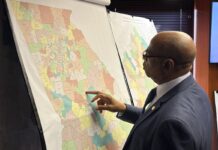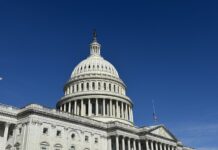
WASHINGTON (States Newsroom) — U.S. Supreme Court justices appeared split Thursday hearing a major case in which the Trump administration defended not only the president’s order to end the constitutional right to birthright citizenship but also its efforts to limit nationwide injunctions.
Though the dispute before the justices relates to the executive order on birthright citizenship that President Donald Trump signed on his Inauguration Day, the Trump administration is asking the high court to focus on the issue of preliminary injunctions granted by lower courts, rather than the constitutionality of the order.
It means that the Supreme Court could potentially limit the power of federal judges in district courts who curtail the president’s authority.
The Trump administration argues that a federal judge granting a nationwide injunction that blocks the federal government from carrying out its policy anywhere in the country is unconstitutional.

The justices had before them three cases with injunctions levied by judges on Trump’s executive order to end birthright citizenship, from courts in Maryland, Massachusetts and Washington state. Under the 14th Amendment, all children born in the United States are considered citizens, regardless of their parents’ legal status.
Trump’s order, originally planned to go into effect Feb. 19, said that children born in the United States would not be automatically guaranteed citizenship if their parents were in the country without legal authorization or if they were on a temporary legal basis such as a work or student visa.
The justices questioned the practicality of a system in which judges can no longer issue nationwide injunctions and the logistics of instead having individuals file their own cases.
Liberal justice Elena Kagan said that would create a chaotic system, and conservative justice Neil Gorsuch said it would produce a “patchwork” of suits and noted how long it takes for a class — a group of affected people — to be put together for a court case.
Nationwide injunctions have stymied Trump’s agenda, but were also frequent during the Joe Biden administration. However, Trump has lashed out at judges who have blocked his actions, which in March prompted a rare response from conservative Chief Justice John Roberts on the importance of an independent judiciary.
‘Stateless’ children
If the Supreme Court, dominated 6-3 by conservatives, decides that nationwide injunctions are not allowed in the birthright citizenship cases, it would temporarily create a patchwork of citizenship rules varying from state to state while the cases are litigated. Liberal Justice Sonia Sotomayor said it would create a class of stateless people.
“Thousands of children who are going to be born without citizenship papers that could render them stateless in some places because some of their parents’ homes don’t recognize children of their nationals unless those children are born in their countries,” she said.
If birthright citizenship were to be eliminated, 255,000 children born each year would not be granted U.S. citizenship, according to a study by the think tank Migration Policy Institute.
40 injunctions since Jan. 20
Arguing on behalf of the Trump administration, U.S. Solicitor General D. John Sauer, in his opening remarks, noted that since Trump took office in January, there have been 40 nationwide injunctions.
“Universal injunctions exceed the judicial power granted in Article III, which exists only to address the injury to the complaining party,” he said, referring to the Constitution. “They transgress the traditional balance of equitable authority, and it creates a host of practical problems.”
Sauer touched on the merits of birthright citizenship, arguing that the 14th Amendment was only meant to grant citizenship to newly freed Black people, and not for immigrants in the country without legal authorization.
“The suggestion that our position on the merits is weak is profoundly mistaken,” Sauer said. “That kind of snap judgment on the merits that was presented in the lower courts is exactly the problem with the issue of racing to issue these nationwide injunctions.”
He said that the Trump administration would follow the high court’s ruling on birthright citizenship.

Demonstrators from the immigration advocacy organization CASA chant “Up up with liberation, down down with deportation” outside of the U.S. Supreme Court on Thursday, May 15, 2025, as justices heard oral arguments on the Trump administration’s legal challenge to birthright citizenship. (Photo by Ashley Murray/States Newsroom)
Sotomayor said that the Supreme Court has ruled four times to uphold birthright citizenship, starting in 1898, in United States v. Wong Kim Ark, in which the court ruled children born in the U.S. are citizens.
The justice that seemed most inclined to agree with Sauer’s argument was conservative Clarence Thomas, who noted the use of nationwide injunctions began in the 1960s and the U.S. has survived without them.
However, conservative Justice Samuel Alito criticized that district court judges “are vulnerable to an occupational disease, which is the disease of thinking that ‘I am right and I can do whatever I want.’”
Citizenship ‘turned on and off’
New Jersey Solicitor General Jeremy Feigenbaum, who represented the states that sought an injunction against the birthright citizenship order, laid out how the patchwork of citizenship means that citizenship would be “turned on” and off depending on state lines.
“Since the 14th Amendment, our country has never allowed American citizenship to vary based on the state in which someone resides, because the post-Civil War nation wrote into our Constitution that citizens of the United States and of the states would be one and the same without variation across state lines,” he said.
Immigrant rights’ groups and several pregnant women in Maryland who are not U.S. citizens filed the case in Maryland; four states — Washington, Arizona, Illinois, and Oregon — filed the case in Washington state; and 18 Democratic state attorneys general filed the challenge in Massachusetts.
Those 18 states are California, Colorado, Connecticut, Delaware, Hawaii, Maine, Maryland, Massachusetts, Michigan, Minnesota, Nevada, New Mexico, New Jersey, New York, North Carolina, Rhode Island, Vermont and Wisconsin. The District of Columbia and the county and city of San Francisco also joined.
Feigenbaum argued that the birthright citizenship case before the justices is the rare instance in which nationwide injunctions are needed because under a patchwork system, a burden would be created for states and local facilities such as hospitals where births occur.

“We genuinely don’t know how this could possibly work on the ground,” he said.
Kelsi Corkran, who argued on behalf of immigrant rights groups, said that the Trump order is “blatantly unlawful,” and that a nationwide injunction against the executive order was warranted.
“It is well settled that preliminary injunctions may benefit non-parties when necessary to provide complete relief to the plaintiffs or when warranted by extraordinary circumstances, both of which are true here,” she said.
Corkran is the Supreme Court director at Georgetown’s Institute for Constitutional Advocacy and Protection.
Lots of injunctions
The justices seemed frustrated with the frequent use of preliminary injunctions from the lower courts not only in the Trump administration, but others that occurred during the Biden administration.
Kagan noted that during the first Trump administration, suits were filed in the more liberal courts of California, and that during the Biden administration suits were filed in the more conservative courts in Texas.
“There is a big problem that is created by that mechanism,” Kagan said.
She added that it’s led to frequent emergency requests to the high court.
Conservative Justice Brett Kavanaugh agreed, and called it a “bipartisan” issue that has occurred during Republican and Democratic presidencies.
While the justices seemed concerned about the frequent use of nationwide injunctions, they also seemed eager to address the merits of the constitutionality of the birthright citizenship executive order that could potentially impact newborns.
Kavanaugh returned to the question of the logistics of birthright citizenship and how it would even be enforced.
He pressed Sauer on how hospitals and local governments would implement the policy and if they would be burdened.
“What would states do with a newborn?” Kavanaugh asked, adding that the executive order requires a quick implementation within 30 days.
Sauer said that hospitals wouldn’t have to do anything differently because the executive order directs the federal government to “not accept documents that have the wrong designation of citizenship from people who are subject to the (executive) order.”
Kavanaugh asked how the federal government would know who is subject to the order.
“The federal officials will have to figure that out,” Sauer said.
Any decision on the case will come before the Supreme Court’s July Fourth recess.







